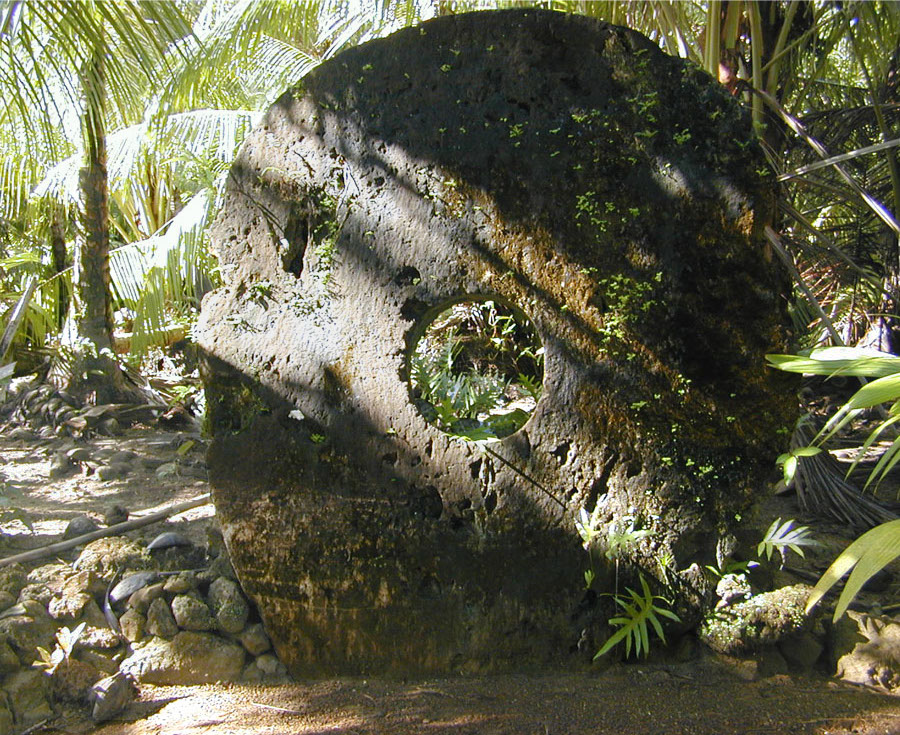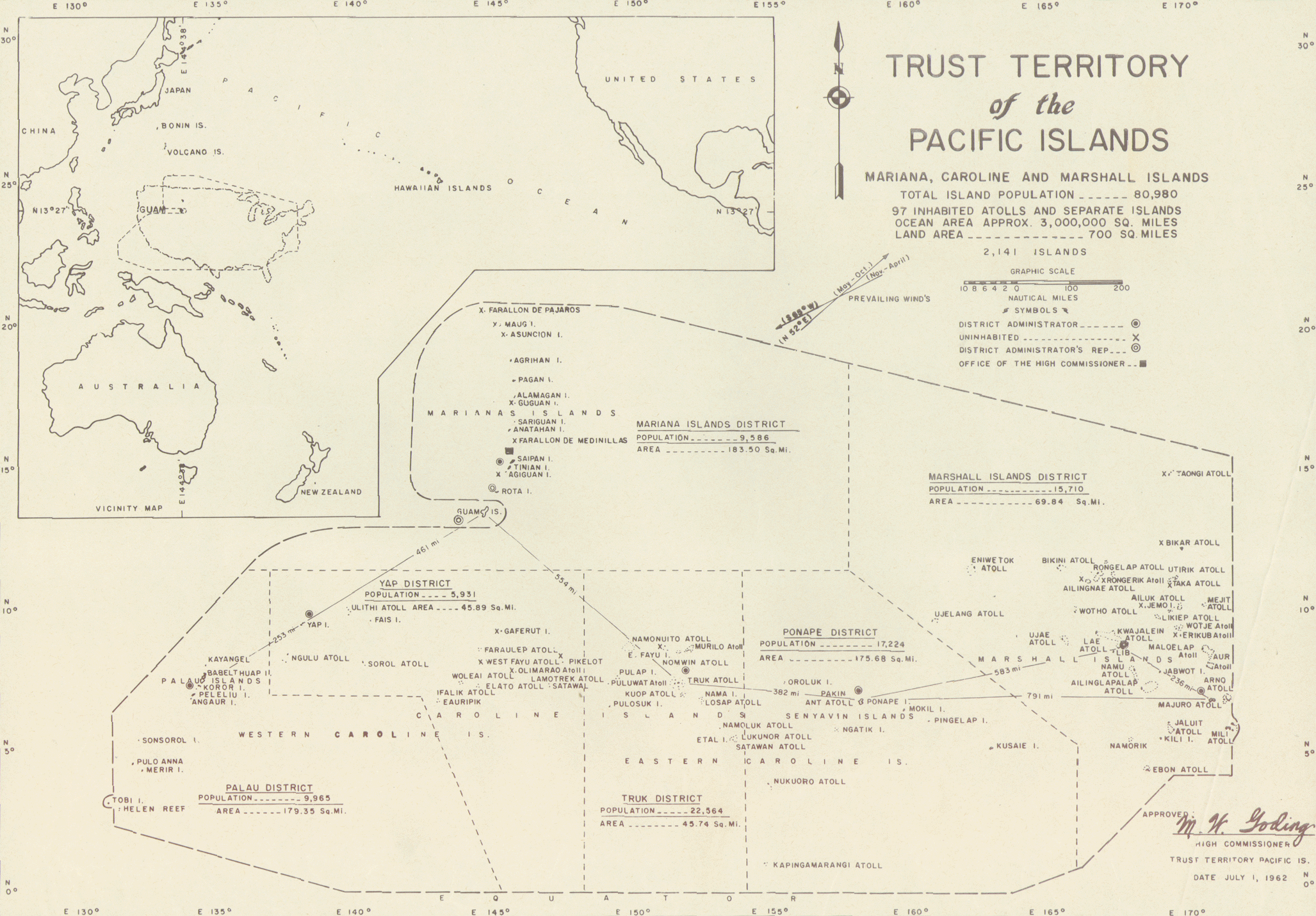|
Tarang (Yap)
Tarang, also known as O'Keefe's Island is a small island in the main harbor of Yap Island in the Federated States of Micronesia. It is located roughly in the center of the harbor east of Colonia, the Yapese capital, between Pekel and Bi Islands. It is a low island with a maximum height of about , and is overgrown with tropical vegetation. The island has local historical importance as the home of Captain David O'Keefe, an enterprising American who arrived on Yap in the 1870s, and was responsible for not only significant economic growth, but also for the depreciation of the distinctive Yapese currency, the large rai stones which became devalued after O'Keefe introduced iron tools that made manufacture of the stones easier. O'Keefe settled on Tarang, where he had a boat landing, coal warehouse, and house. Of these structures, only the boat landing has survived; only foundations survive of the others. The island was listed on the United States National Register of Historic Place ... [...More Info...] [...Related Items...] OR: [Wikipedia] [Google] [Baidu] |
Federated States Of Micronesia
The Federated States of Micronesia (; abbreviated FSM) is an island country in Oceania. It consists of four states from west to east, Yap, Chuuk, Pohnpei and Kosraethat are spread across the western Pacific. Together, the states comprise around 607 islands (a combined land area of approximately ) that cover a longitudinal distance of almost just north of the equator. They lie northeast of Indonesia and Papua New Guinea, south of Guam and the Marianas, west of Nauru and the Marshall Islands, east of Palau and the Philippines, about north of eastern Australia, 3,400 km (2,133 mi) southeast of Japan, and some southwest of the main islands of the Hawaiian Islands. While the FSM's total land area is quite small, the country's waters occupy more than of the Pacific Ocean, giving the country the 14th-largest exclusive economic zone in the world. The sovereign island nation's capital is Palikir, located on Pohnpei Island, while the largest city is Weno, located in ... [...More Info...] [...Related Items...] OR: [Wikipedia] [Google] [Baidu] |
Colonia, Yap
Colonia is an urban area belonging to the municipalities of Rull and Weloy which serves as the capital of the State of Yap, one of the Federated States of Micronesia. It administers both Yap proper and some 13 atolls and islands reaching to the east and south for some . The 2010 Census population was 3,126. A Spanish Catholic The Catholic Church, also known as the Roman Catholic Church, is the largest Christian church, with 1.3 billion baptized Catholics worldwide . It is among the world's oldest and largest international institutions, and has played a ... mission was established in Colonia in 1885, during Yap's time as a colony of Spain. Tomil Harbor is the main port of Yap State. Ships have to travel through a reef-bordered passageway to reach the port, where there is a small craft wharf. Education Public schools: [...More Info...] [...Related Items...] OR: [Wikipedia] [Google] [Baidu] |
David O'Keefe (ship Captain)
David Dean O'Keefe (1824 or 1828 – 1901) was an Irish-American ship captain who became a historical and political figure on the Western Pacific island of Yap. O'Keefe emigrated to the United States in 1848 and established himself in Savannah, Georgia. In 1871 he captained a ship to the Western Pacific. After landing on Yap he became powerful by using tools from Hong Kong and East Asia to more easily create Rai stones; however, the ease of making the stone money ultimately helped lead to its decline during the period of German rule. Still the wealth allowed him to own an island, of which he was considered "king". Reportedly he had his own emblem, which showed the US flag waving over the letters "O K." He took two Yapese wives, despite already having a wife and daughter in Savannah. In 1901 he died on the ship ''Santa Cruz'' returning to Savannah. ''His Majesty O'Keefe'' is the story of O'Keefe's life on Yap. A film of the same name starring Burt Lancaster was made in 1954. ... [...More Info...] [...Related Items...] OR: [Wikipedia] [Google] [Baidu] |
Rai Stones
A rai stone ( yap, raay), or fei stone, is one of many large artifacts that were manufactured and treasured by the native inhabitants of the Yap islands in Micronesia. They are also known as Yapese stone money or similar names. The typical rai stone is carved out of crystalline limestone and is shaped as a disk with a hole in the center. The smallest may be in diameter. The largest extant stone is located on Rumung island, near the Riy village; it is in diameter and thick, and weighs . Rai stones were quarried on several of the Micronesian islands, mainly Palau, but briefly on Guam as well. The practice stopped in the early 20th century. Today there are around 6,000 large rai stones outstanding in the island, and several can be seen in museums around the world. The stones were highly valued by the Yapese, and used for important ceremonial gifts. The ownership of a large stone, which would be too difficult to move, was established by its history as recorded in oral tradit ... [...More Info...] [...Related Items...] OR: [Wikipedia] [Google] [Baidu] |
National Register Of Historic Places
The National Register of Historic Places (NRHP) is the United States federal government's official list of districts, sites, buildings, structures and objects deemed worthy of preservation for their historical significance or "great artistic value". A property listed in the National Register, or located within a National Register Historic District, may qualify for tax incentives derived from the total value of expenses incurred in preserving the property. The passage of the National Historic Preservation Act (NHPA) in 1966 established the National Register and the process for adding properties to it. Of the more than one and a half million properties on the National Register, 95,000 are listed individually. The remainder are contributing resources within historic districts. For most of its history, the National Register has been administered by the National Park Service (NPS), an agency within the U.S. Department of the Interior. Its goals are to help property owners and inte ... [...More Info...] [...Related Items...] OR: [Wikipedia] [Google] [Baidu] |
Trust Territory Of The Pacific Islands
The Trust Territory of the Pacific Islands (TTPI) was a United Nations trust territory in Micronesia administered by the United States from 1947 to 1994. History Spain initially claimed the islands that later composed the territory of the Trust Territory of the Pacific Islands (TTPI).''Encyclopædia Britannica''Trust Territory of the Pacific Islands/ref> Subsequently, Germany established competing claims over the islands. The competing claims were eventually resolved in favor of Germany when Spain, following its loss of several possessions to the United States during the Spanish–American War, ceded its claims over the islands to Germany pursuant to the German–Spanish Treaty (1899). Germany, in turn, continued to retain possession until the islands were captured by Japan during World War I. The League of Nations formally placed the islands in the former South Seas Mandate, a mandate that authorized Japanese administration of the islands. The islands then remained under Jap ... [...More Info...] [...Related Items...] OR: [Wikipedia] [Google] [Baidu] |
Islands Of Yap
An island (or isle) is an isolated piece of habitat that is surrounded by a dramatically different habitat, such as water. Very small islands such as emergent land features on atolls can be called islets, skerries, cays or keys. An island in a river or a lake island may be called an eyot or ait, and a small island off the coast may be called a holm. Sedimentary islands in the Ganges delta are called chars. A grouping of geographically or geologically related islands, such as the Philippines, is referred to as an archipelago. There are two main types of islands in the sea: continental and oceanic. There are also artificial islands, which are man-made. Etymology The word ''island'' derives from Middle English ''iland'', from Old English ''igland'' (from ''ig'' or ''ieg'', similarly meaning 'island' when used independently, and -land carrying its contemporary meaning; cf. Dutch ''eiland'' ("island"), German ''Eiland'' ("small island")). However, the spelling of the word ... [...More Info...] [...Related Items...] OR: [Wikipedia] [Google] [Baidu] |




